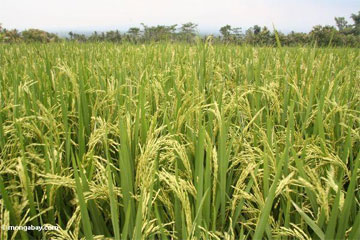World cereal production forecast to decrease in 2006
the United Nations Food and Agriculture Organization
May 7, 2006
Worldwide, 39 countries are in need of external food assistance — the majority required for drought-affected and chronically food insecure populations in southern and eastern Africa, according to a new FAO report released today.
World cereal production is forecast to decrease slightly in 2006 after last year’s good levels, the report said.
The report warns that if global cereal use in 2006/2007 remains close to recent trends it would exceed the current forecast for production, which could lead to a drawdown of global cereal stocks for the second consecutive year.
Africa
The greatest number of food emergencies continues to be in Africa, where 24 countries are currently in need of assistance, largely due to adverse weather conditions, conflict and economic crisis.
In eastern Africa, recent rains have somewhat eased drought conditions in pastoral areas of Ethiopia, Somalia, Kenya and Djibouti, but nearly 8 million people are still suffering from the effects of prolonged drought. When the chronically vulnerable populations in these countries are included, the number of people at risk from hunger jumps to about 16 million, FAO says.
In Sudan and Eritrea, despite this year’s good harvests, large numbers of people continue to require humanitarian assistance as a consequence of past and current conflicts, the report said.
In southern Africa, the difficult food situation of some 12 million people has eased with the current good 2006 cereal harvest and food aid distributions. The 2006 main maize crop, currently being gathered, is anticipated to recover from last year’s drought with the exception of Angola. In South Africa, lower production this year is compensated by large remaining stocks from 2004/2005.
In western Africa, the 2005/2006 cereal crop was estimated at above average levels in both coastal and Sahelian countries, mainly reflecting favourable growing conditions during the season. In the Sahel countries, however, in spite of a recovery from last year’s drought and locust-affected harvest, a combination of low incomes, high debts and relatively high food prices is limiting access to food by many households, and malnutrition rates remain alarmingly high in numerous areas.
Asia
In Asia, the outlook for the 2006 wheat crop being harvested has deteriorated in India, but it is positive among other main producers in the region.
Emergency assistance is needed in Mongolia and Timor-Leste following sharply reduced cereal production in 2005/2006. Substantial amounts of food assistance are also required for chronically vulnerable populations in DPR Korea and Bangladesh, in spite of overall improved food supply situations, as well as for those affected by civil strife in Afghanistan, Iraq and Nepal, the report said.
Protracted assistance also continues to be required for the victims of the tsunami in southern Asia and last October’s earthquake in Pakistan.

|
|
Latin America and the Caribbean
In Latin America and the Caribbean, 2006 wheat output is anticipated to be substantially up in Mexico. Sharply reduced maize output is forecast in Argentina, but production will recover in Brazil. However, Brazil’s rice crop is expected to be well below the record level of 2005. In Paraguay, the soybean crop will again be sharply reduced by dry weather.
2006 global cereal crop prospects
Wheat output is expected to decrease in 2006 reflecting smaller crops in the United States, the Russian Federation and Ukraine, due to adverse weather. Production of coarse grains is tentatively forecast to decline, mostly as a result of reduced plantings anticipated in the United States. Rice output may increase as very early prospects are favourable, according to the report.
Crop Prospects and Food Situation consolidates and replaces two previous FAO Global Information and Early Warning System (GIEWS) publications, Foodcrops and Shortages and the Africa Report. Scheduled to be published six times a year, it will provide information on the latest developments affecting global cereal supply and demand, as well as regional overviews of the crop prospects and food security situation, including a list of countries in crisis requiring external assistance, and the cereal balance position of low-income food-deficit countries.
This article is a modified news release from the United Nations Food and Agriculture Organization.